
The Mahābhārata is one of the two major Smriti texts and Sanskrit epics of ancient India revered in Hinduism, the other being the Rāmāyaṇa. It narrates the events and aftermath of the Kurukshetra War, a war of succession between two groups of princely cousins, the Kauravas and the Pāṇḍavas.

Hindu mythology is the body of myths attributed to, and espoused by, the adherents of the Hindu religion, found in Sanskrit texts such as the Vedic literature, epics like Mahabharata and Ramayana, the Puranas, and mythological stories specific to a particular ethnolinguistic group like the Tamil Periya Puranam and Divya Prabandham, and the Mangal Kavya of Bengal. Hindu myths are also found in widely translated popular texts such as the fables of the Panchatantra and the Hitopadesha, as well as in Southeast Asian texts.
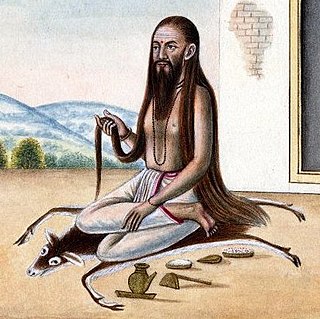
Bharadvaja was one of the revered Vedic sages (maharishi) in Ancient India. He was a renowned scholar, economist, grammarian, physician and a follower of Maha Pashupata. He is one of the Saptarishis.
Indian epic poetry is the epic poetry written in the Indian subcontinent, traditionally called Kavya. The Ramayana and the Mahabharata, which were originally composed in Sanskrit and later translated into many other Indian languages, and the Five Great Epics of Tamil literature and Sangam literature are some of the oldest surviving epic poems ever written.
Hindu texts or Hindu scriptures are manuscripts and voluminous historical literature which are related to any of the diverse traditions within Hinduism. Some of the major Hindu texts include the Vedas, the Upanishads, and the Itihasa. Scholars hesitate in defining the term "Hindu scriptures" given the diverse nature of Hinduism, but many list the Agamas as Hindu scriptures, and Dominic Goodall includes Bhagavata Purana and Yajnavalkya Smriti in the list of Hindu scriptures as well.

Urvashi is the most prominent apsara mentioned in the Hindu scriptures like the Vedas, the epics Ramayana and Mahabharata, as well as the Puranas. She is regarded as the most beautiful of all the apsaras, and an expert dancer.
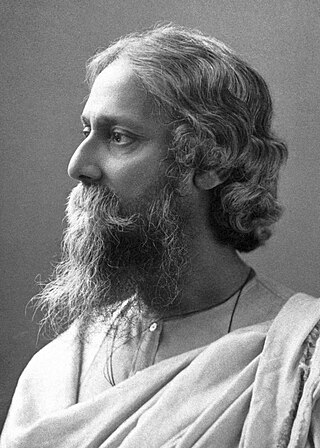
Bengali literature denotes the body of writings in the Bengali language and which covers Old Bengali, Middle- Bengali and Modern Bengali with the changes through the passage of time and dynastic patronization or non-patronization. Bengali has developed over the course of roughly 1,300 years. If the emergence of the Bengali literature supposes to date back to roughly 650 AD, the development of Bengali literature claims to be 1600 years old. The earliest extant work in Bengali literature is the Charyapada, a collection of Buddhist mystic songs in Old Bengali dating back to the 10th and 11th centuries. The timeline of Bengali literature is divided into three periods: ancient (650–1200), medieval (1200–1800) and modern. Medieval Bengali literature consists of various poetic genres, including Hindu religious scriptures, Islamic epics, Vaishnava texts, translations of Arabic, Persian and Sanskrit texts, and secular texts by Muslim poets. Novels were introduced in the mid-19th century. Nobel laureate Rabindranath Tagore is the best known figure of Bengali literature to the world. Kazi Nazrul Islam, notable for his activism and anti-British literature, was described as the Rebel Poet and is now recognised as the National poet of Bangladesh.

Bannanje Govindacharya was an Indian philosopher and Sanskrit scholar versed in Veda Bhashya, Upanishad Bhashya, Mahabharata, Puranas and Ramayana. He wrote Bhashyas (commentaries) on Veda Suktas, Upanishads, ShataRudriya, Brahma Sutra Bhashya, Gita Bhashya and was an orator. He was awarded the Padma Shri by the Government of India in 2009.
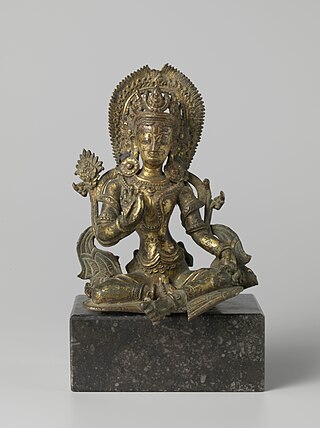
Indrani, also known as Shachi, is the queen of the devas in Hinduism. Described as tantalisingly beautiful, proud and kind, she is the daughter of the asura Puloman and the consort of the king of the devas, Indra.

In Hindu cosmology, the Ocean of Milk is the fifth from the centre of the seven oceans. It surrounds the continent known as Krauncha. According to Hindu scriptures, the devas and asuras worked together for a millennium to churn this ocean in order to acquire amrita, the elixir of immortal life. The episode is mentioned in the Samudra Manthana chapter of the Puranas, a body of ancient Hindu legends. The Kshira Sagara is described as the place where the deity Vishnu reclines over his serpent-mount Shesha, accompanied by his consort, Lakshmi.

Romesh Chunder Dutt was an Indian civil servant, economic historian, translator of Ramayana and Mahabharata. He was one of the prominent proponents of Indian economic nationalism.
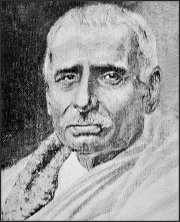
Hara Prasad Shastri, also known as Hara Prasad Bhattacharya, was an Indian academic, Sanskrit scholar, archivist, and historian of Bengali literature. He is most known for discovering the Charyapada, the earliest known examples of Bengali literature.

Shuka is a rishi (sage) in Hinduism. He is the son of the sage Vyasa and the main narrator of the scripture Bhagavata Purana. Most of the Bhagavata Purana consists of Shuka reciting the story to the king Parikshit in his final days. Shuka is depicted as a sannyasi, renouncing the world in pursuit of moksha (liberation), which most narratives assert that he achieved.
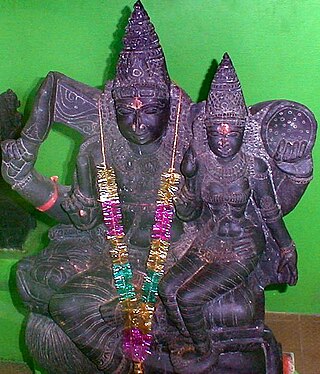
Ila or Ilā is a deity in Hindu legends, known for their sex changes. As a man, he is known as Ila or Sudyumna and as a woman, is called Ilā. Ilā is considered the chief progenitor of the Lunar dynasty of Indian kings – also known as the Aillas.
The Abhira people were a legendary people mentioned in ancient Indian epics and scriptures as early as the Vedas. A historical people of the same name are mentioned in the Periplus of the Erythraean Sea. The Mahabharata describes them as living near the seashore and on the bank of the Sarasvati River, near Somnath in Gujarat and in the Matsya region also.
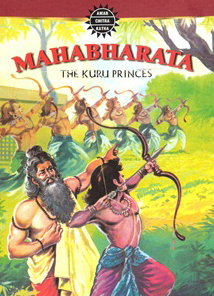
Mahabharata is a comic adaptation of the Indian epic poem Mahabharata. The 42-issue best-selling series by Amar Chitra Katha, Mumbai was illustrated by Dilip Kadam. The team of script writers included Kamala Chandrakant, TMP Nedungadi, Subba Rao, Yagya Sharma, Lopamudra, Mihir Lal Mitra, Sumona Roy, Mohan Swaminathan, Shubha Kandhekar and Margie Sastry.
A subhashita is a literary genre of Sanskrit epigrammatic poems and their message is an aphorism, maxim, advice, fact, truth, lesson or riddle. Su in Sanskrit means good; bhashita means spoken; which together literally means well spoken or eloquent saying.

The Puranic chronology is a timeline of Hindu mythology based on the Mahabharata, the Ramayana, and the Puranas. The central dates here are the Kurukshetra War and the Lanka War with the start of the start and end of the Kali Yuga and the other yugas and all the other events in Hindu mythology. The Puranic chronology is referred to by proponents of Indigenous Aryans to propose an earlier dating of the Vedic period, and the spread of Indo-European languages out of India, arguing that "the Indian civilization must be viewed as an unbroken tradition that goes back to the earliest period of the Sindhu-Sarasvati Valley traditions ."














